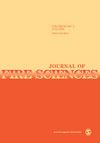可膨胀石墨的各向异性以解释其作为阻燃剂的行为
IF 1.9
4区 工程技术
Q2 ENGINEERING, MULTIDISCIPLINARY
引用次数: 2
摘要
可膨胀石墨在聚合物中用作阻燃剂。它在加热时膨胀,形成一个石墨蠕虫网络,起到热障的作用。然而,蠕虫的作用机制尚不清楚。提出了一种新颖的实验方法来研究蠕虫网络的散热问题。该网络是在锥形量热仪实验中用10%可膨胀石墨燃烧聚丙烯制成的。烧完后,在炭上加一个热点。在燃烧过程中和应用热点后,监测样品不同位置的温度。在锥量热法中,炭在整个样品上均匀地发展。热点实验证明了石墨蠕虫纠缠网络的各向异性。这种热传导性的各向异性使得热在平面内散失,而在平面外散失很差,这就解释了缠虫产生的热障效应。本文章由计算机程序翻译,如有差异,请以英文原文为准。
Anisotropy of expandable graphite to explain its behavior as a flame-retardant
Expandable graphite is used as a flame-retardant in polymers. Its expansion on heating leads to a network of graphite worms which acts as a thermal barrier. However, mechanisms of action of worms are not yet well known. An original experimental approach is performed to study the heat dissipation in the network of worms. The network is made by the burning of polypropylene with 10 wt% expandable graphite during cone calorimeter experiment. After the burning, a hot spot is applied on the char. Temperature is monitored at different locations of sample during the combustion and after the application of the hot spot. During cone calorimetry, the char develops homogeneously over the whole sample. The hot spot test evidences the anisotropy of the entangled network of graphite worms. This anisotropy of heat conductivity allows the dissipation of heat in-plane and poorly out of plane, which explains the thermal barrier effect made by entangled worms.
求助全文
通过发布文献求助,成功后即可免费获取论文全文。
去求助
来源期刊

Journal of Fire Sciences
工程技术-材料科学:综合
CiteScore
4.00
自引率
0.00%
发文量
14
审稿时长
2.5 months
期刊介绍:
The Journal of Fire Sciences is a leading journal for the reporting of significant fundamental and applied research that brings understanding of fire chemistry and fire physics to fire safety. Its content is aimed toward the prevention and mitigation of the adverse effects of fires involving combustible materials, as well as development of new tools to better address fire safety needs. The Journal of Fire Sciences covers experimental or theoretical studies of fire initiation and growth, flame retardant chemistry, fire physics relative to material behavior, fire containment, fire threat to people and the environment and fire safety engineering. This journal is a member of the Committee on Publication Ethics (COPE).
 求助内容:
求助内容: 应助结果提醒方式:
应助结果提醒方式:


